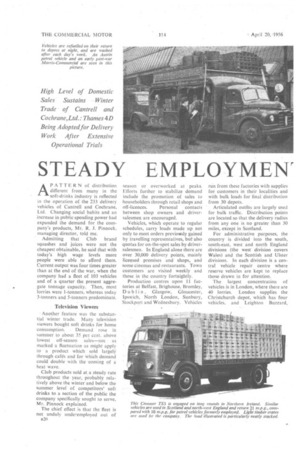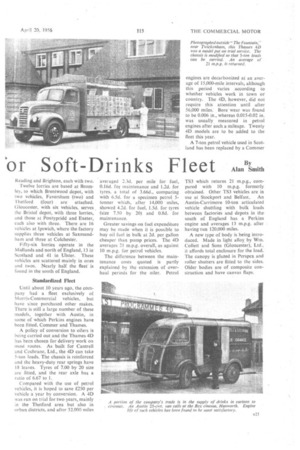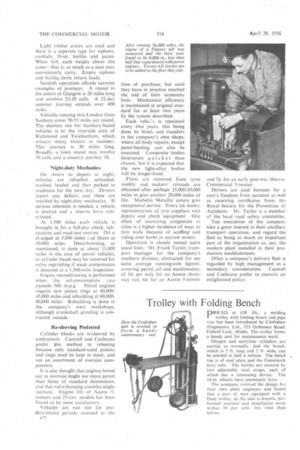STEADY EMPLOYMENT'
Page 54

Page 55

Page 56

If you've noticed an error in this article please click here to report it so we can fix it.
br Soft-Drinks Fleet
Alan Smith High Level of Domestic Sales Sustains Winter Trade• of Cantrell and Cochrane,Ltd.: Thames 4D Being Adopted for Delivery Work After Extensive Operational Trials
APATTERN of distribution different from many in the soft-drinks industry is reflected in the operation of the 233 delivery vehicles of Cantrell and Cochrane, Ltd. Changing social habits and an increase in public spending power had expanded the demand for the company's products, Mr. R. J. Pinnock, managing director, told me.
Admitting that Club brand squashes and juices were not the cheapest obtainable, he said that with today's high wage levels more people were able to afford them. Current output was four times greater than at the end of the war, when the company had a fleet of 103 vehicles and of a quarter the present aggregate tonnage capacity. Then, most lorries were 1-tonners, whereas today 3-tonners and 5-tonners predominate.
Television Viewers
Another feature was the substantial winter trade. Many television viewers bought soft drinks for home consumption. Demand rose in summer to about 35 per cent, above lowest off-season sales—not as marked a fluctuation as might apply to a product which sold largelY through cafes and for Which demand could double with the coming of a heat wave.
Club products sold at a steady rate throughout the year, probably relatively above the winter and below the summer level of competitors' soft drinks to a section of the public the company specifically sought to serve, Mr. Pinnock explained.
The chief effect is that the fleet is not unduly underemployed out of a20
season or overworked at peaks. Efforts further to stabilize demand include the promotion of sales to householders through retail shops and off-licences. Personal contacts between shop owners and driversalesmen are encouraged.
Vehicles, which operate to regular schedules, carry loads made up not only to meet orders previously gained by travelling representatives, but also quotas for on-the-spot sales by driversalesmen. In England alone there are over 30,000 delivery points, mainly licensed premises and shops, and some cinemas and restaurants. Town customers are visited weekly and those in the country fortnightly.
Production centres upon 11 factories at Belfast, Brighouse, Bromley, Dublin, Glasgow, Gloucester, Ipswich, North London, Sunbury, Stockport and Wednesbury. Vehicles run from these factories with supplies for customers in their localities and with bulk loads for final distribution from 30 depots.
Articulated outfits are largely used for bulk traffic. Distribution points are located so that the delivery radius from any one is no greater than 30 miles, except in Scotland.
For administrative purposes, the country is divided into the south, south-east, west and north England divisions (the westdivision covers Wales) and the Scottish and Ulster divisions. In each division is a central vehicle repair centre where reserve vehicles are kept to replace those drawn in for attention.
The largest concentration of vehicles is in London, where there are 40 lorries. London supplies the Christchurch depot, which has four vehicles, and Leighton Buzzard, Reading and Brighton, each with two.
Twelve lorries are based at Bromley, to which Brentwood depot, with two vehicles, Faversham (two) and
hetford (four) are. attached. Gloucester, with six vehicles, serves . the Bristol depot, with three lorries, and those at Pontypridd and Exeter, each also with three. There are 16 vehicles at Ipswich, where the factory supplies three vehicles at Saxmundham and three at Colchester.
Fifty-six lorries operate in the Midlands and north of England, 13 in Scotland and 41 in Ulster. These vehicles are scattered mainly in ones and twos. Nearly half the fleet is found in the south of England.
Standardized Fleet
Until about 10 years ago, the company had a fleet exclusively of Morris-Commercial vehicles, but have since purchased other makes. There is still a large number of these models, together with Austin, in some of which Perkins engines have been fitted, Commer and Thames.
A policy of conversion to oilers is being carried out and the Thames 4D has been chosen for delivery work on most routes. As built for Cantrell and Cochrane, Ltd., the 4D can take 5-ton loads. The chassis is reinforced and the heavy-duty rear springs have 18 leaves. Tyres of 7.00 by 20 size are fitted, and the rear axle has a ratio of 6.67 to 1..
Compared with the use of petrol vehicles, it is hoped to save £250 per vehicle a year by conversion. A 4D was run on trial for two years, mainly in the Thetford area but also in urban districts, and after 32,000 miles
averaged 2.3d. per mile for fuel, 0.16d. for maintenance and 1.2d. for tyres, a total of 3.66d., comparing with 6.5d. for a specimen petrol 5tonner which, after 14,000 miles, showed 4.2d. for fuel, 1.5d. for tyres (size 7.50 by 20) and 0.8d. for maintenance.
Greater savings on fuel expenditure may be made when it is possible to buy oil fuel in bulk at 2d. per gallon cheaper than pump prices. The 4D averages 21 m.p.g. overall, as against 10 m.p.g. for petrol vehicles.
The difference between the maintenance costs quoted is partly explained by the extension of overhaul periods for the oiler. Petrol
TS3 which returns 21 m.p.g., compared with 10 m.p.g. formerly obtained. Other TS3 vehicles are in use at Stockport and Belfast, An Austin-Carrimore 10-ton articulated vehicle shuttling with bulk loads between factories and depots in the south of England has a Perkins engine and averages 13 m.p.g. after havinga-un 120,000 miles.
A new type of body is being introduced. Made in light alloy by Wm. Collett and Sons (Gloucester), Ltd., it affords total enclosure for the load. The canopy is glazed in Perspex and roller shutters are fitted to the sides. Older bodies are of composite construction and have canvas flaps.
Light timber crates are used and there is a separate type for siphons, cordials, 10-oz. bottles and juices. When full, each weighs about the same—that is, as much as a man may conveniently carry. Empty siphons and bottles form return loads.
Scottish operation affords extreme examples of journeys. A round in the centre of GlaSgOW is 20 miles long and involves 23-30 calls. A 21-day summer journey extends over 400 miles.
Vehicles running into London from Sunbury cover 50-55 miles per round: The shortest run for Sunbury-based vehicles is to the riverside area of Richmond and Twickenham, which attracts many visitors in summer. This journey is 30 miles long. Broadly, a town round may involve 30 calls and a country journey 18.
Night-duty Mechanks
On return to depots at night, vehicles are refuelled, unloaded, washed, loaded and then parked in readiness for the next day. Drivers report any defects and these are rectified by night-duty mechanics. If serious attention is needed, a vehicle is docked and a reserve lorry substituted.
At 1,500 miles each vehicle is
• brought in for a full-day check, lubrication and road-test routine. Oil is -changed at 3,000 miles Lad filters at 10,000 miles. Decarbonizing, as mentioned, is done at about 15,000 miles in the case of petrol vehicles, or cylinder heads may be removed for valve regrinding if weak compression is detected at a 1,500-mile inspection. Engine reconditioning is performed when the oil-consumption rate
exceeds 500 tn.p.g. Petrol engines require new piston rings at 40,00045,000 miles and rebuilding at 60,00080,000 miles. Rebuilding is done in the company's own workshops, although crankshaft grinding is contracted outside.
Re-sleeving Preferred
Cylinder blocks are re-sleeved by contractors. Cantrell and Cochrane prefer this method to reboring because only standard-sized pistons and rings need be kept in stock, and not an assortment of oversize components.
It is also thought that engines bored out to oversize might use more petrol than those of standard dimensions, and that valve-burning troubles might increase. Engine life of Austin 5tormers and 25-cwt. models has been found to be most satisfactory.
Vehicles are run not for predetermined periods assesk'd at the 13.22. time of purchase, but until they have in practice reached the end of their economic lives. Mechanical efficiency is maintained at original standard for at least two years by the system described.
Each vehi.f_.: is repainted every two years, this being done by brush and transfers in the company's own shops, where all body repairs, except panel-beating, can also he executed. Composite bodies deteriorate quicker than chassis, but it is expected that the new light-alloy bodies will be longer-lived. •
Flints are removed from tyres weekly and makers' retreads are obtained after perhaps 25,000-30,000 miles to give another 20,000 miles of life. Michelin Metallic covers give exceptional service. Every six weeks, representatives of tyre. suppliers visit depots and check equipment. One effect of increasing congestion in cities is a higher incidence of wear to tyre walls because of scuffing and riding over kerbs in narrow streets.
Operation is closely costed upon usual lines. Mr. Frank Taylor, transport manager for the company's southern division, abstracted for me some average running-cost figures, covering petrol, oil and maintenance, of 3d. per mile for an Austin threeway van, 6th for an Austin 5-tonner and 7d. for an early post-war MorrisCommercial 5-tonner, Drivers are paid • bonuses for a year's freedom from accident as well as receiving certificates from the Royal Society for the -Prevention of Accidents. Mr. Taylor is a member of the local road safety committee.
Top executives of the company take a great interest in their ancillary transport operation, and regard the fleet as being as much an important part of the organization as, say, the modern plant installed in their production establishments.
Often a company's delivery fleet is regarded by high management as a secondary consideration. Cantrell and Cochrane prefer to exercise an enlightened policy.




















































































































